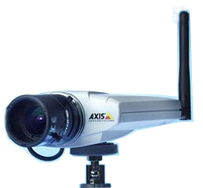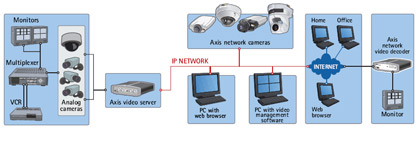SourceSecurity.com took the time to catch up with the CEO and President of the company that invented the network camera more than 10 years ago, Axis Communications, to ask him whether the era of IP-based surveillance had arrived and what obstacles remain in the way of more widespread adoption.
SourceSecurity.com: Do you think IP-Surveillance has finally come of age?
Ray Mauritsson: Yes and it is not just Axis saying this. You only need to look at the growth of sales of the network video market to see the evidence. IMS Research's latest report gave growth figures for the network video market in the region of 40% globally and our own network video sales slightly exceed this figure with 45% growth in 2006. CCTV market growth, by comparison, stands at around 10%. I think these figures reveal a definite swing towards IP-based deployment which is good news for the whole IP- Surveillance community.
SourceSecurity.com: Why are customers moving to IP-based solutions now?
Ray Mauritsson: We recognized from the start that the transition from analog to IP was going to be a slow but steady one that would only be achieved through a strong focus on education of key parties and supporting and helping to grow a community around IP-Surveillance.
For example, we have been focused for several years on educating the end user market on the benefits of moving surveillance systems on to the network. Key benefits like the ability to do cost effective remote monitoring via the network; use of existing network infrastructure rather than dedicated coaxial cabling for CCTV systems, ease of integration with other security systems have all led to increased IP deployments.
For the past four years we have also been running a global technical training program for Axis partners amongst the security installer and IT integrator communities. Called the Axis Academy, this program helps interested partners to develop the skills and knowledge required to successfully implement IP-Surveillance solutions. Globally the numbers of Axis Academy trained partners now exceeds 3,000. Axis is now tailoring training programmes to both traditional security installers and IT integrators.
| Growth of the network video market IMS Research's latest report gave growth figures for the network video market in the region of 40% globally and our own network video sales slightly exceed this figure with 45% growth in 2006. CCTV market growth, by comparison, stands at around 10%. |
SourceSecurity.com: Have there been any wider developments that have stimulated sales of network cameras?
Ray Mauritsson: The vast number of analog CCTV cameras out there is ageing all the time. In the UK alone you have some 4.5 million out in the field with an average life expectancy of about ten years and as these cameras are being replaced network cameras and network video implementations are being naturally considered and deployed now.

Again we recognize that to harness all the innovation going on in the video application world an open approach is essential - we can only go so far with hardware innovation even if we are launching 20 new products per year.
The truth is that there are no longer any good technical reasons to select CCTV over network cameras and all we have to do is win over the hearts and minds of the CCTV community, especially the more traditional security installers and end-users.SourceSecurity.com: What other macro developments are contributing to the shift?
Ray Mauritsson: We are seeing quite a few large customers now adopting a new approach to managing their video data. These companies want to make video data as accessible (to authorized and authenticated stakeholders) as any other type of corporate data.
They also want to manage video application servers as part of their total IT infrastructures. This change is forcing centralisation of security system buying into the hands of the IT department heads at a fairly rapid pace as organizations begin to see the strong Return on Investment arguments of deploying video surveillance across an existing network infrastructure rather than maintaining a dedicated closed circuit solution with all the attendant costs of upgrading and maintaining that are implied by this.SourceSecurity.com: Can you explain the importance of about your Application Development Partners (ADPs) going forward?
Ray Mauritsson: The 440 ADPs and nearly 12,000 integrators we work with are vital to our success. Their applications and solutions drive adoption of network video just as much as our own product innovation. The growth in intelligent video analysis will be driven by our ADPs who are already developing and rolling out diverse solutions in areas such as Automatic Number Plate Recognition (ANPR), people counting and retail Point of Sale transaction analysis. This leaves us to focus on providing the best and most open portfolio of network video solutions.
SourceSecurity.com: There is a lot spoken about intelligent video analysis right now, how do you see this market developing?
Ray Mauritsson: Anything that adds value to our products is clearly of great value to us. Although the market for intelligent video analysis is still in its infancy we are fortunate enough to be working alongside some leading software players on developments in areas including people counting, visual exception reporting (e.g. unaccompanied bags left in an airport) as well as D-fence and motion detection-based solutions.
It is very exciting in that it offers yet another reason to move away from analog-based solution where integration is more of a problem. We are seeing strong sales in a number of markets including the retail, transportation, education, government, healthcare and industrial markets. Many of these markets are also early adopters of specialist intelligent video analysis solutions.
SourceSecurity.com: What other benefits are flowing from remaining open?
Ray Mauritsson: We are also now seeing an increased uptake of horizontal security integration so that increasingly there is demand to link our cameras into access control, fire detection, intruder alarms and wider building management systems. 
SourceSecurity.com: You seem to be doing a great deal, where next for Axis?
Ray Mauritsson: We recently hired our 500th employee opened our 18th office in Dubai towards the end of 2006. We saw very strong growth in the US last year and all geographical regions are performing well despite increased competition in the all markets.
SourceSecurity.com: Do you see the big global brand's increased focus on IP and away from CCTV as a concern for you?
Ray Mauritsson: It is a sign that the market is reaching a size where the big brands can no longer ignore the growth of IP. They are now actively looking for a piece of the action. Their moves simply legitimise the position that we have held for more than 10 years - a stance that has provided us with a market leading position in this growing market.
Even if our share of the market becomes diluted through their efforts retaining a significant share of a market that is growing at 40% CAGR offers very significant benefits for the foreseeable future.
SourceSecurity.com: What then has been the secret of Axis' success to date and what will sustain you going forward?
Ray Mauritsson: One word - focus. Axis has been focused on researching and bringing to market high quality network video products for more than 10 years. Axis' early mover advantage has enabled it to establish early dominance of the market for both video servers and network camera markets.
Axis' focus on creating a strong technology platform for its products with the optimized ASICs, ETRAX and ARTPEC, further strengthens its position in terms of price and quality.
Finally, Axis' use of open architecture to build its products has enabled a large number of integrators and application developers to deploy our products in areas that might otherwise have proved difficult for them.
Ray Mauritsson is the CEO and President of Axis Communications




















